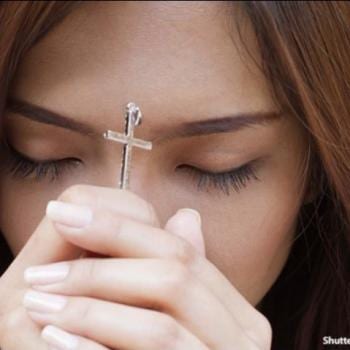In these descriptive essays, guest contributor, Susan L. Miller, captures the incarnational dimension that lies at the heart of both Catholicism and art. It is sometimes difficult for us to see fashion as art. In a sense, fashion is too physical, too concrete. It clothes bodies after all. What’s more, there is an aspect to fashion that is extremely particular. Clothing does not cover some kind of universal and abstract idea of “body.” It covers this *particular* body – the body of a pope, or a celebrity, or a woman. It can shock us to consider fashion an art form, but there is a parallel here to the shocking nature of the Incarnation. Christ was a particular person, and we are assured that he is to be found in the particularity of each person. Grace works mysteriously, and it is part of the work of grace to help us to find God in the particular, whether that’s in a pair of red shoes worn by a pope, or a dress worn by Kim Kardashian, or in a person we see every day.
Note: photographs are prohibited in this portion of the exhibit
The Vatican’s trove of garments and jewels takes up two relatively small rooms in the basement of the Met. Finding the space is a bit challenging – although once you discover it, you realize that nearly everyone who’s visiting the museum has risen to this challenge. The rooms are packed, especially the room of jewels, in which you’ll stand shoulder to shoulder with other viewers as if in a subway car. The work is staggeringly intricate, labeled with the names of the Popes who wore it, and built by a number of often anonymous hands. In the age of minimalist Pope Francis, this excess can be a shocking – I remain overwhelmed even after two separate visits, each of which offered more to contemplate.
In the front room are the fabric fashions – chasubles, capes, even John Paul II’s red shoes, crafted in suede and leather, resembling an oxblood dancing shoe. The first case is disarming. It contains a pair of finely crafted but fairly simple gold and silver St. Peter’s keys by G. Landi, the shoes of John Paul II, and a Pope’s white ensemble (the same sort that we almost always see on Pope Francis, whose insistence on simplicity includes his wear of everyday dress in plain fabrics on almost all occasions.) When Pope Benedict XVI wore red shoes designed by Prada, the media took note, throwing shade on him for being such a fashion-plate. (The Prada shoes are nowhere to be seen in this exhibition, though they are noted in the text.) However, looking at the rest of this room full of ceremonial garments, the viewer finds that Benedict XVI pales in comparison to just about any Pope named Leo, Pius, or Benedict from the 18th and 19th centuries.
After the case of “simple” garments (a case with three mantles of white cloth, embroidered and decorated with paillettes and gold embroidery) starts the more opulent party. These objects are equally exquisite in design and execution – they must have taken hundreds of hours to embroider by hand – but most impressive to me is the mantle of Benedict XV, which bears a smaller capelet with an embroidered Dove of the Holy Spirit, surrounded with golden rays of light created by hundreds of tiny paillettes. The Handmaids of the Sacred Heart of Jesus gave this mantle to the Pope on the occasion of the canonization of Saint Margherita Maria Alacoque. (This was in 1920, almost contemporary with the much simpler, but still exquisite, 1939 Jeanne Lanvin blue dress upstairs.) Each of these mantles would have covered the body of the Pope with a long train which would have extended several feet behind him – not long enough for a wedding dress, but certainly long enough to create an impression. These garments were designed for one purpose: to make the Pope’s presence felt, as a holy person representative of the King of Heaven. Their detail, their grandeur, and even their white cloth evoke his holiness. The exhibition catalog reminds us that the color white is meant to indicate divinity of purpose, which is why it was reserved for Popes, brides, baptised infants, and, traditionally, medical personnel – though you’d be more likely to find nurses in polka dots or with cartoon characters on their scrubs today. which reminds us that, in a religious context, some traditions are worth keeping.
Even more stunning are a series of chasubles, copes, and other vestments created by a group of fifteen anonymous women for Pope Pius IX. The catalog explains,
“Commissioned by Empress Maria Anna Carolina of Austria, this suite of vestments was made by the Istituto Femminile di Don Nicola Mazza, founded in Verona in 1828 as a refuge and training facility to cultivate the virtue of young girls” (51.)
According to the text accompanying the garments, it took 15 of these women nearly 16 years to complete the embroidery on the dozen chasubles, copes, and other vestments. The stitching on these garments is so fine as to look like painting, and the images on them – of Christ crowned with thorns, Christ flogged, Abraham at the point of sacrificing Isaac, and other Biblical stories – often refer to famous paintings of these events. The stitches themselves are so fine that the silk appears to have been embroidered by fairy hands. It’s difficult to imagine any of our contemporaries having the time to do such work, or that any atelier would train someone to do it. In the West, our traditions of such work diminish in direct proportion to their valuation, and in a world of fast fashion, and even of Fashion Weeks, no one can afford to take such time with a garment. However, these young women in the mid-1800s took the time, and whether their moments of stitching were also moments of contemplation, we cannot say. We have no record in this exhibition of their thoughts, their lives, or any details of their processes. Popes and patrons were considered great; their names are the ones attached to these garments. These embroidering girls were enjoined instead in the Little Way, like St. Therese of Lisieux, by virtue of their tiny stitches. Yet it is their work that lasts–that we are privileged to see here, close up, both sides displayed in glass cases so that our noses stop only an inch from the surface of the fabric.
Most of the other garments – a heavily embroidered cope with golden images of Biblical characters, a dalmatic of Pius IX decorated with wheat and grapes in a reference to Holy Communion – are in keeping with the work done on the three mantles. An exceptional chasuble, made for Pius XI “by the Poor Clare Sisters of the Monastery of Saint Clare of the Sacred Heart of Mazamet,” rounds out the collection. It stands out by virtue of its smaller images, narrative content, and extraordinary beauty. An image of Mary flanked by St. Francis of Assisi and St. Clare circles the throat of the wearer, and on the chest just below is “an image of Pius XI proclaiming the dogma of the Immaculate Conception” (45). Other small panels depict scenes from the life of St. Francis. They include the vision he had of the Cross in San Damiano, his formation of the Friars Minor, his audience with the Pope, and multiple images of his evangelization of children in North Africa, ostensibly during his peaceful Crusade visit, when he befriended the Sultan of Egypt. Another panel on the chest shows his contemporary followers offering roses and lilies to Pope Pius XI. This embroidery is smaller and simpler than the highly decorative and painterly embroidery of the Istituto Femminile women, but it achieves great emotionality in the faces and bodies of its subjects. Even tiny background figures display tremendous vigor in their postures and narrative content in their actions. Made to commemorate the 700th anniversary of St. Francis’s death, this garment is less flashy, but no less impressive than the others.
The jewel room contains work at a level that is even too opulent for the contemporary church. Several Papal tiaras show a degree of wealth that seems almost obscene, even in a world in which 8 individuals own as much wealth as half of the human race (according to a 2017 study by Oxfam.) One of these tiaras has over 19,000 jewels adorning it, most of them diamonds. The Papal Mitres alongside them are less opulent, but they are by no means minimal – each is decorated with jewels, gold embroidery, and made of cloth of silver or silk satin and gold brocade. Many of the items in this room – pectoral crosses, diamond rings – were gifts from royalty. One of the mitres was “a gift from Italian Prime Minister Benito Mussolini to commemorate the signing of the Lateran treaty on February 11, 1929,” according to the catalog. It is strikingly beautiful, with a crucified Christ adorning its front center and a Virgin and Child on the back. However, its association with Mussolini and the political pact achieved between the Vatican and Italian governments diminishes its beauty for me. I can’t help but think of the historical difference that might have been if St. Teresia Benedicta of the Cross, also known as Edith Stein, had written about Hitler’s persecution of the Jews to a Pope who had not been so agreeable to the dictator.
I have not been able to see these objects outside of their political and historical context, in part because they display the extraordinary political and social power that the Catholic Church has wielded in the world. Yet there’s something wonderful in being able to see these objects, pieces of history that teach us both the profundity of religious feeling, and the complexity of the Church’s position in the world, whether in Fascist Italy, in the Crusades, or in the rarefied world of haute couture. These items have never before been accessible at this close level to ordinary New Yorkers, ordinary Americans. Of course there is beauty in religious practice, and the Catholic Church traffics in beauty more than any other religious body in the world, in my opinion. The ornate and sublime don’t have to be part of religious practice – both St. Francis of Assisi and his namesake, our Pope, seem to have gotten by just fine without too much of that. But even St. Francis rejected his usual self-abnegation when his good friend, a noble lady, offered him sweet cakes once in a while. Museums are not often repositories of the humble, the ordinary, or the simple. And when one thinks of the tradition of the great Renaissance painters – Van Eyck, Bosch, Raphael – one wonders if the level of detail in couture may be the only contemporary art which continues that tradition of opulence, narrative, and attention to the importance of detail in the creation of a sense of the sublime. Paying my dollar entry fee, stepping into the worlds of high art created for the body, in service of the divine, I feel the swirl of all my emotions about being a Catholic. In my reverence for God’s creation, and my respect for the designers who honor our Catholic tradition (be they famous or anonymous, gay or straight, male or female, lapsed or faithful, and all highly skilled), I feel grateful to have been in the presence of work that still has so much to teach about the importance of grace, and the responsibility of our Church to bear witness to that grace in the lives of ordinary people.
(I have referred to a number of texts in the course of these reviews, chiefly among them the catalog for the Exhibition, Heavenly Bodies I: The Vatican Collection, II: Fashioning Worship, and III: Fashioning Devotion, by Andrew Bolton with Barbara Drake Boehm, Marzia Cataldi Gallo, C. Griffith Mann, David Morgan, Gianfranco Cardinal Ravasi, and David Tracy. I also referred in this essay to a historical incident in which, in 1933, Edith Stein, then a Carmelite nun, wrote to Pope Pius XI about the fate of the Jewish people under Hitler’s rule, asking for an audience with him, and which he answered with good wishes for her and her family, but no discussion of her question. This incident is explored in greater detail in chapter 13 of Edith Stein: The Life of a Philosopher and Carmelite by Teresia Renata Posselt, O.C.D., edited by Susanne M. Batzdorff, Josephine Koeppel, and John Sullivan.)
Susan L. Miller is the author of Communion of Saints: Poems, and has poems in the anthologies Collective Brightness: LGBTIQ Poets on Faith, Religion, and Spirituality and St. Peter’s B-List: Contemporary Poems Inspired by the Saints. She teaches creative writing at Rutgers University and lives in Brooklyn, NY, with her family.
Photographs are her own.












